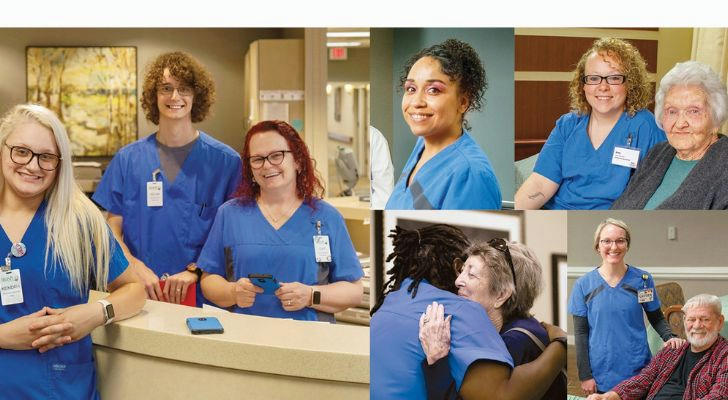Learn While You Earn: U.S. Department of Labor–Backed CNA Apprenticeship Programs
For those looking to step into healthcare without prior experience, Certified Nursing Assistant (CNA) apprenticeships offer a practical, hands-on training path. Supported by the U.S. Department of Labor, these programs allow individuals to receive training and real-world experience—all while actively contributing in the healthcare field.

Why Choose a Department of Labor CNA Apprenticeship Program?
These programs go beyond traditional training. They combine job readiness, professional development, and workplace mentorship to create a robust career path in healthcare.
1. 🏧️ Backed by Government Support
These apprenticeships are developed in collaboration with healthcare providers, training centers, and state agencies. Participants benefit from programs that remove common entry barriers, making healthcare training more attainable for individuals of various educational and professional backgrounds.
2. 🧠 Practical Skill Building with Real Impact
Participants are trained in key areas of patient care including:
Hygiene and mobility assistance
Basic clinical tasks (vital signs, dressing changes, etc.)
Communication with patients and healthcare staff
Responding to emergencies and supporting recovery
This hands-on training ensures apprentices aren’t just learning from a book—they’re building skills in real-time with real patients.
3. 👩⚕️ Paid, On-the-Job Learning with Stipends
Apprentices earn a wage while completing training under supervision, typically ranging from $14.00 to $16.00 per hour. This model allows for steady income and reduces financial strain during the training period. There are no standardized testing requirements to start, and many programs offer flexible admissions, welcoming individuals with a passion for caregiving—regardless of academic history.
🔄 Long-Term Career Growth
This program is not just a stepping stone — it’s a structured pathway to long-term success. Participants receive:

144 hours of Indiana and U.S. Department of Labor–approved training
Guidance from clinical instructors throughout the entire course
One-on-one, on-the-job mentoring with experienced CNAs
Coursework and exam preparation to ensure certification success
Training focused on in-demand healthcare roles with strong long-term growth potential
Graduates often transition directly into full-time positions in hospitals, long-term care centers, or home health agencies, and may later pursue LPN or RN licensure as they continue to advance.
Upon completion of the apprenticeship, participants will not only earn a Certified Nursing Assistant (CNA) license but also receive a Registered Apprenticeship Completion Certificate issued by the U.S. Department of Labor. The typical service duration is one year, ensuring comprehensive experience and a strong foundation in healthcare.
📝 Basic requirements for applying for a job
To qualify, individuals must:
Be at least 16 years old
Successfully complete basic English, reading, and math assessments
Pass a criminal background check and drug screening
These standards ensure apprentices are well-prepared and reliable as they begin their careers in healthcare.
📄 How to Apply
🔍 Research Local Programs
Search online through state workforce agency websites or the U.S. Department of Labor’s apprenticeship portal. Many states maintain an active list of CNA programs.
🏥 Contact Local Healthcare Providers
Hospitals, clinics, and elder care facilities often run their own apprenticeship programs. Inquire at HR departments or training offices.
✍️ Submit an Application
Fill out the program’s application form with personal information, availability, and interest in healthcare. Some may request a short interview or orientation before enrollment.
⭐ Real-Life Success in Action
Take the story of Michelle, a single mother who once worked in hospitality. She was looking for a stable career that also allowed her to care for others. Through her local Department of Labor-supported apprenticeship, she began CNA training at a nearby healthcare center.
Michelle learned everything from helping patients with daily tasks to documenting care details and communicating with nurses. By the end of her training, she was hired full-time and now helps mentor new apprentices in her facility.

🏥 Where CNA Apprentices Work
Apprenticeships prepare participants for a wide variety of healthcare environments:
🏨 Hospitals – Support nurses with daily patient care, monitor vital signs, and assist with medical procedures.
🏠 In-Home Care – Provide essential services for patients in their own homes, especially the elderly and those recovering from surgeries.
🦳 Long-Term Care Facilities – Assist aging residents or those with chronic illnesses, creating safe and supportive daily routines.
🏃 Rehabilitation Centers – Work alongside therapists and healthcare staff to help patients recover mobility and independence.
🏤 Outpatient Clinics – Support medical staff in conducting check-ins, guiding patients, and performing routine procedures.
The skills learned through these apprenticeships are transferable across the healthcare system, creating multiple paths for growth and specialization.
📈 Growing Demand = More Opportunity
According to the Bureau of Labor Statistics, CNA positions are projected to grow steadily over the next decade, driven by an aging population and the rising need for long-term care.
Apprenticeship graduates are well-positioned to meet this demand with practical training and real experience already under their belts. Many programs also offer career counseling or direct connections to local employers.
🎯 Conclusion: A Smart First Step Into Healthcare
CNA apprenticeships offer more than just a job—they provide a foundation in one of the most meaningful and stable industries today. With government backing, on-the-job learning, and career support built in, this training path opens the door for thousands to begin a healthcare journey with confidence.
For anyone eager to make a difference while learning and earning, CNA apprenticeships offer a practical, supportive, and purposeful path forward.
